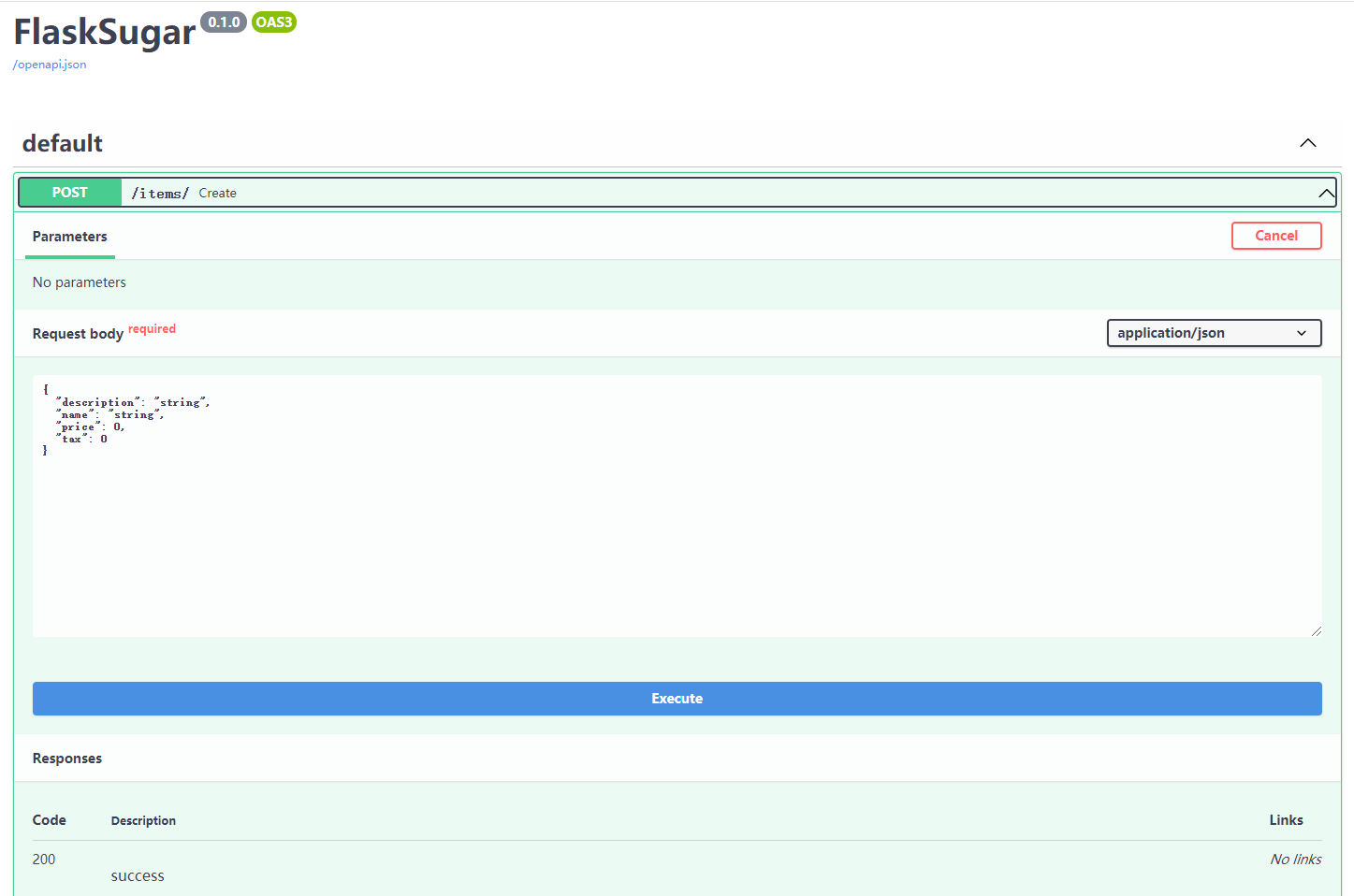Request Body
When you need to send data from a client (let's say, a browser) to your API, you send it as a request body.
A request body is data sent by the client to your API. A response body is the data your API sends to the client.
Your API almost always has to send a response body. But clients don't necessarily need to send request bodies all the time.
To declare a request body, you use Pydantic models with all their power and benefits.
Import Pydantic's BaseModel
First, you need to import BaseModel from pydantic:
from typing import Optional
from flask_sugar import Sugar
from pydantic import BaseModel
app = Sugar(__name__)
class Item(BaseModel):
name: str
description: Optional[str] = None
price: float
tax: Optional[float] = None
@app.post("/items/")
def create(item: Item):
return item
Create your data model
Then you declare your data model as a class that inherits from BaseModel.
Use standard Python types for all the attributes:
from typing import Optional
from flask_sugar import Sugar
from pydantic import BaseModel
app = Sugar(__name__)
class Item(BaseModel):
name: str
description: Optional[str] = None
price: float
tax: Optional[float] = None
@app.post("/items/")
def create(item: Item):
return item
The same as when declaring query parameters, when a model attribute has a default value, it is not required. Otherwise, it is required. Use None to make it just optional.
For example, this model above declares a JSON "object" (or Python dict) like:
{
"name": "Foo",
"description": "An optional description",
"price": 45.2,
"tax": 3.5
}
...as description and tax are optional (with a default value of None), this JSON "object" would also be valid:
{
"name": "Foo",
"price": 45.2
}
Declare it as a parameter
To add it to your path operation, declare it the same way you declared path and query parameters:
from typing import Optional
from flask_sugar import Sugar
from pydantic import BaseModel
app = Sugar(__name__)
class Item(BaseModel):
name: str
description: Optional[str] = None
price: float
tax: Optional[float] = None
@app.post("/items/")
def create(item: Item):
return item
...and declare its type as the model you created, Item.
Results
With just that Python type declaration, Flask Sugar will:
- Read the body of the request as JSON.
- Convert the corresponding types (if needed).
- Validate the data.
- If the data is invalid, it will return a nice and clear error, indicating exactly where and what was the incorrect data.
- Give you the received data in the parameter
item.- As you declared it in the function to be of type
Item, you will also have all the editor support (completion, etc) for all of the attributes and their types.
- As you declared it in the function to be of type
- Generate JSON Schema definitions for your model, you can also use them anywhere else you like if it makes sense for your project.
- Those schemas will be part of the generated OpenAPI schema, and used by the automatic documentation UIs.
Automatic docs
The JSON Schemas of your models will be part of your OpenAPI generated schema, and will be shown in the interactive API docs:

And will be also used in the API docs inside each path operation that needs them:

Use the model
Inside of the function, you can access all the attributes of the model object directly:
from typing import Optional
from flask_sugar import Sugar
from pydantic import BaseModel
app = Sugar(__name__)
class Item(BaseModel):
name: str
description: Optional[str] = None
price: float
tax: Optional[float] = None
@app.post("/items/")
def create(item: Item):
item_dict = item.dict()
if item.tax:
price_with_tax = item.price + item.tax
item_dict.update({"price_with_tax": price_with_tax})
return item_dict
Request body + path parameters
You can declare path parameters and request body at the same time.
Flask Sugar will recognize that the function parameters that match path parameters should be taken from the path, and that function parameters that are declared to be Pydantic models should be taken from the request body.
from typing import Optional
from flask_sugar import Sugar
from pydantic import BaseModel
app = Sugar(__name__)
class Item(BaseModel):
name: str
description: Optional[str] = None
price: float
tax: Optional[float] = None
@app.put("/items/<item_id>")
def create(item_id: int, item: Item):
return {"item_id": item_id, **item.dict()}
Request body + path + query parameters
You can also declare body, path and query parameters, all at the same time.
Flask Sugar will recognize each of them and take the data from the correct place.
from typing import Optional
from flask_sugar import Sugar
from pydantic import BaseModel
app = Sugar(__name__)
class Item(BaseModel):
name: str
description: Optional[str] = None
price: float
tax: Optional[float] = None
@app.post("/items/<item_id>")
def create(item_id: int, item: Item, q: Optional[str] = None):
result = {"item_id": item_id, **item.dict()}
if q:
result.update({"q": q})
return result
The function parameters will be recognized as follows:
- If the parameter is also declared in the path, it will be used as a path parameter.
- If the parameter is of a singular type (like
int,float,str,bool, etc) it will be interpreted as a query parameter. - If the parameter is declared to be of the type of a Pydantic model, it will be interpreted as a request body.
Note
Flask Sugar will know that the value of q is not required because of the default value = None.
The Optional in Optional[str] is not used by Flask Sugar, but will allow your editor to give you better support and detect errors.